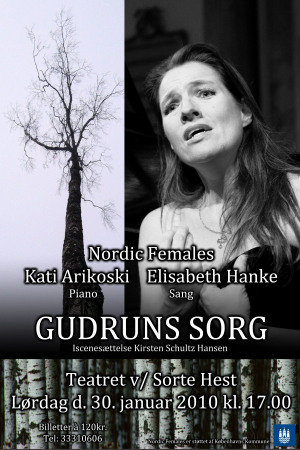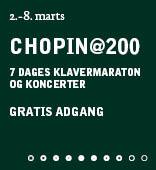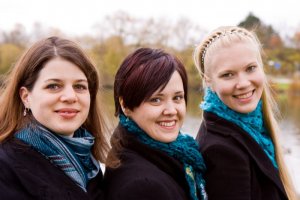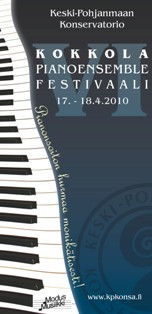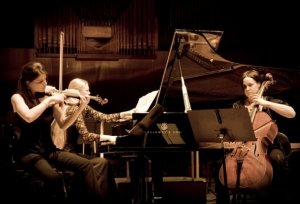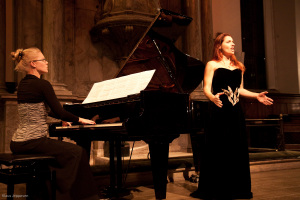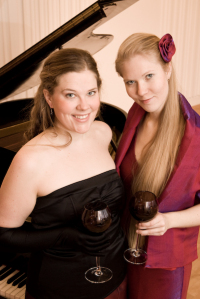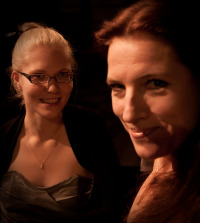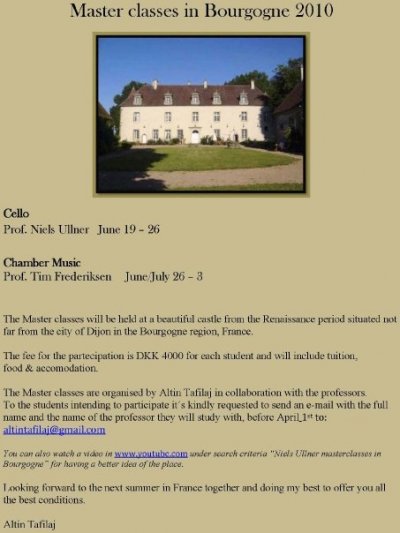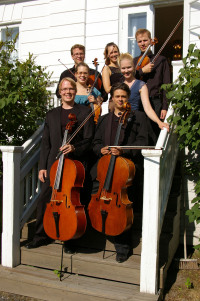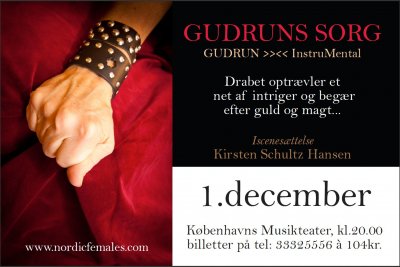Concert Calendar
RSS2010
-
Fri29Jan2010
Lied concert
17:00 Teatret ved Sorte Hest
Vesterbrogade 150
1620 Copenhagen
Denmark
Nordic Females… Kati Arikoski & Elisabeth Hanke,
Concert with combination of Heise, Gudrun Sorg and females…
Context is Gudrun and Heise in a staged version! Great concert in the concept of Nordic Females, performed by Nordic Females!
Director for “Gudrun” is Kirsten Schultz-Hansen
-
Mon01Feb2010
Master Class
DKDM
Rosenørns Allé 22
Frederiksberg C
Denmark
2.-4.2 Master Class with pianist Andrzej Jasinski (Poland) in DKDM
Kati Arikoski is playing Frédéric Chopin: Andante spianato et Grande Polonaise brillante in E-flat major, Op. 22,
which was composed between 1830 and 1834. The Grande Polonaise brillante in E-flat, set for piano and orchestra, was written first, in 1830-31. In 1834, Chopin wrote an Andante spianato in G, for piano solo, which he added to the start of the piece, and joined the two parts with a fanfare-like sequence. The combined work was published in 1836 as Op. 22, and was dedicated to Madame d’Este.
-
Fri12Feb2010
Piano & Organ Concert
15:00 Sankt Andreas Kirke, Malmö
Fridhemstorget 217 53 Malmö
21753 Malmö
Sweden
Kati Arikoski & Robert Bennes are playing a work by Belgian composer Flor Peeters (1903-1986):
Concerto for Organ and Piano op. 75
I Introduzione ad Allegro
II Arioso (Larghetto espresivo)
III Cadenza (Allegro maestosp) e finale (Allegro vivo e fermo) -
Fri26Feb2010
Chopin@200
14:00 Det Jyske Musikkonservatorium
Skovgaardsgade 2C, 8000 Århus C
8000 Århus
Denmark
Chopin festival på DJM, 26.-28.2. 2010, Lille Sal i Musikhuset
Get the full program of the festival here
Kati Arikoski is playing 27.2 in a marathon concert which takes place 14-19.00 Frédéric Chopin: Andante spianato et Grande Polonaise brillante in E-flat major, Op. 22,
which was composed between 1830 and 1834. The Grande Polonaise brillante in E-flat, set for piano and orchestra, was written first, in 1830-31. In 1834, Chopin wrote an Andante spianato in G, for piano solo, which he added to the start of the piece, and joined the two parts with a fanfare-like sequence. The combined work was published in 1836 as Op. 22, and was dedicated to Madame d’Este.
-
Sun28Feb2010
Master Class
10:15 DKDM
Rosenørns Allé 22
Frederiksberg C
Denmark
Master Class 1.3 with pianist Wojciech Switala (Poland)
Kati Arikoski is playing Frédéric Chopin: Andante spianato et Grande Polonaise brillante in E-flat major, Op. 22
The work was composed between 1830 and 1834. The Grande Polonaise brillante in E-flat, set for piano and orchestra, was written first, in 1830-31. In 1834, Chopin wrote an Andante spianato in G, for piano solo, which he added to the start of the piece, and joined the two parts with a fanfare-like sequence. The combined work was published in 1836 as Op. 22, and was dedicated to Madame d’Este.
-
Sat06Mar2010
Chopin @200
12:00 DKDM
Rosenørns Allé 22
Frederiksberg C
Denmark
7 days piano festival with concerts and lectures of Chopin. It is 200 years from his birth.
Chopin@200 Festival is arranged by Det Kongelige Danske Musikkonservatorium together with Det Jyske Musikkonservatorium, Palladium i Malmø and Den polske ambassade i København.
Get the full program of the Festival here
It is free to attend the all arrangements of the festival.
Kati Arikoski is playing in Maraton concert (at 12.00-20.00) in Chopin Festival
Frédéric Chopin: Andante spianato et Grande Polonaise brillante in E-flat major, Op. 22,
which was composed between 1830 and 1834. The Grande Polonaise brillante in E-flat, set for piano and orchestra, was written first, in 1830-31. In 1834, Chopin wrote an Andante spianato in G, for piano solo, which he added to the start of the piece, and joined the two parts with a fanfare-like sequence. The combined work was published in 1836 as Op. 22, and was dedicated to Madame d’Este.
AND at 18.00 Frédéric Chopin: Variations on a Theme of Moore,for piano four hands, KKIVa/6, CT.228,
which was written when Chopin was a student living in Warsaw, this is the composer’s only known work for piano, four-hands. Though it is an early effort, it is still of sufficient substance to make it worthy of the attention of both pianists and public. Part of its general neglect stems from its four-hand status, never a popular venue for pianists, though audiences have generally been favorable to it. When a duo team is formed, however, their preferences tend to be in the realm of two-piano repertory. (~ All Music Guide)
-
Sat13Mar2010
Chopin@200
15:00 Palladium Malmö
Södergatan 15, 21134 Malmö
21134 Malmö
Sweden
Chopin Festival continues!
Home page of Palladium
ProgramKati Arikoski is playing 14.3 Frédéric Chopin: Andante spianato et Grande Polonaise brillante in E-flat major, Op. 22,
which was composed between 1830 and 1834. The Grande Polonaise brillante in E-flat, set for piano and orchestra, was written first, in 1830-31. In 1834, Chopin wrote an Andante spianato in G, for piano solo, which he added to the start of the piece, and joined the two parts with a fanfare-like sequence. The combined work was published in 1836 as Op. 22, and was dedicated to Madame d’Este.
-
Wed24Mar2010
Trio Concert
20:00 Mantziusgårdens Koncertsal
Johan Mantziusvej 7
Birkerød
Denmark
Unge talenter fra Konservatoriet.
Professor Tim Frederiksens kammermusikelever.
TRIO GIMELIA:
Janina Müller, violin
Carla Kuotila, cello
Kati Arikoski, piano
Klavertrioen Trio GimeliaJoseph Haydn: Klavertrio nr. 24, G-dur
Dimitrij Sjostakowitj: Klavertrio nr. 2, e-mol
Johannes Brahms: Klavertrio nr. 3, c-mol
-
Thu15Apr2010
Piano Duo Concert
17:00 Central Ostrobothnia Conservatory
Pitkänsillankatu 16 67100 Kokkola Suomi/Finland
67100 Kokkola
Finland
Kati Arikoski & Anna-Mari Murdvee are performing in Piano Ensemble festival in Kokkola
Program of the festival click here
C. Saint-Saëns : Le Carnaval des Animaux (The Carnival of the Animals)
I- Introduction et marche royale du Lion (Introduction and Royal March of the Lion)
II- Poules et Coqs (Hens and Roosters)
III- Hémiones (animaux véloces) (Wild Asses; quick animals)
IV- Tortues (Tortoises)
V- L’Éléphant (The Elephant)
VI- Kangourous (Kangaroos)
VII- Aquarium
VIII- Personnages à longues oreilles (Characters with Long Ears)
IX- Le coucou au fond des bois (The Cuckoo in the Depths of the Woods)
X- Volière (Aviary)
XI- Pianistes (Pianists)
XII- Fossiles (Fossils)
XIII- Le Cygne (The Swan)
XIV- FinaleF. Chopin: Variations on a theme of Moore, for piano, 4 hands, in D major
F. Schubert: Fantasie in F minor, op. 103, D940 -
Thu22Apr2010
Night Concert
21:30 DKDM
Rosenørns Allé 22
Frederiksberg C
Denmark
Trio Gimelia spiller natkoncert i Konservatoriets Koncertsal umiddelbart efter aftenens koncert med Sjællands Symfoniorkester.
TRIO GIMELIA:
Janina Müller, violin
Carla Kuotila, cello
Kati Arikoski, piano -
Thu27May2010
Beethoven & Schumann & Brahms
20:00 Christians Kirke
Strandgade 1, 1401 København K
1401 Copenhagen
Danmark
Ludwig van Beethoven: Klaviertrio Nr. 3 op. 1, 3 C-Moll – I. Allegro con brio, Trio Gimelia
In Beethoven’s compositions C minor is commonly regarded as a special key: works in this key are usually very dramatic and emotionally stormy. So is the C minor trio, which is characterized by strong contrasts in dynamics and harmonic innovations.
In the first movement Beethoven anticipates the explosive developments with its strong contrasts of dolce pianissimos and powerful fortissimos, an effect that became increasingly characteristic of Beethoven.R. Schumann Frauen Lieben un Leben, Kati Arikoski & Elisabeth Hanke
1.”Seit ich ihn gesehen” (“Since I Saw Him”)
2.”Er, der Herrlichste von allen” (“He, the Noblest of All”)
3.”Ich kann’s nicht fassen, nicht glauben” (“I Cannot Grasp or Believe It”)
4.”Du Ring an meinem Finger” (“You Ring Upon My Finger”)
5.”Helft mir, ihr Schwestern” (“Help Me, Sisters”)
6.”Süßer Freund, du blickest mich verwundert an” (“Sweet Friend, You Gaze”)
7.”An meinem Herzen, an meiner Brust” (“At My Heart, At My Breast”)
8.”Nun hast du mir den ersten Schmerz getan” (“Now You Have Caused Me Pain for the First Time”)Frauenliebe und -leben (A Woman’s Love and Life) is a cycle of poems by Adelbert von Chamisso, written in 1830. They describe the course of a woman’s love for her man, from her point of view, from first meeting through marriage to his death, and after.
J. Brahms: Piano trio C minor, op. 101, Trio Gimelia
I Allegro energico
II Presto non assai
III Andante grazioso
IV Allegro moltoBrahms komponerede sin Klavertrio op. 101 i c-mol i 1886 under et sommerophold i Thun, Schweiz. Samtidig skrev han også Cellosonaten i F-dur op. 99 og Violinsonaten i A-dur op. 100. Trioen blev spillet første gang i sommeren 1886 umiddelbart efter dens færdiggørelse i digteren J. V. Widmanns hus i Bern, og blev uropføret senere samme år i Budapest med Brahms selv ved klaveret.
Brahms venner var meget begejstrede for trioen. Således skrev f. eks. Clara Schumann, at ingen af Brahms værker havde fascineret hende så meget som dette. Og Elisabeth von Herzogenberg, hvis musikalske dømmekraft Brahms satte meget højt, mente, at netop dette værk portrætterede Brahms bedre end noget fotografi.
De to ydersatser, Allegro energico og Allegro molto, er meget lidenskabelige og bevægende og skaber en imponerende ramme om den mystiske Presto non assai og den uskyldige Andante grazioso. -
Mon07Jun2010
Ariettes oubliées
18:00 DKDM
Rosenørns Allé 22
Frederiksberg C
Denmark
C. Debussy: Ariettes oubliées
Kati Arikoski, klaver
Angelica Larsson Asp, sopranNo. 1. C’est l’extase
No. 2 Il pleure dans mon coeur
No. 3 L’ombre des arbres
No. 4. Chevaux de bois
No. 5. Green
No. 6. SpleenThe first item in Ariettes oubliées is typical of Verlaine’s work and a highly adept musical setting by Debussy: the gauzy, floating melodic line perfectly reflects the text of C’est l’extase langoureuse, in all its languorous ecstasy. Next is Il pleure dans mon coeur, with the piano accompanying the long vocal lines with what would become Debussy’s typical “raindrop” music; the singer notes that it rains in her heart as it rains in the town, but can’t understand the source of her sadness. “It’s pain’s darkest state/not to know why/without love, without hate/my heart feels such weight.”
The third song is L’ombre des arbes (The Shadows of the Trees), another doleful piece in which the singer’s state of mind reflects (rather than is reflected by) a sad, solemn landscape. Everything brightens significantly with Chevaux de bois, initially celebrating the energy of merry-go-round horses turning in their circular route, although midway through the mood changes to sadness and wistfulness, reflecting the knowledge that these are not living creatures.
The last two songs are “Green” and “Spleen” — the titles are in English, because Verlaine liked their sound. Debussy, following Verlaine, referred to this pair of songs as aquarelles, and the music does have a light, wispy, watercolor character. “Green” is a love song that begins with offerings from nature (fruits, flowers, leaves in the trees) and ends with a falling into slumber. “Spleen” is a song of despair — the sky is too blue, the sea too green, all because the loved one has done something “atrocious.” The vocal line becomes intentionally monotonous, and the music fades away, listlessly
-
Tue08Jun2010
Kul'tour-uge Taastrup
19:00 Taastrup Nykirke
Birkedalsvej 2
2630 Taastrup
Glæd dig til KUL´TOUR 2010
TEMAET er LOKAL & GLOBALProgram of the festival click here
Kati Arikoski, piano & Elisabeth Hanke, alt
R. Schumann & P. Heise
R. Schumann Frauen Lieben un Leben, Kati Arikoski & Elisabeth Hanke
1.”Seit ich ihn gesehen” (“Since I Saw Him”)
2.”Er, der Herrlichste von allen” (“He, the Noblest of All”)
3.”Ich kann’s nicht fassen, nicht glauben” (“I Cannot Grasp or Believe It”)
4.”Du Ring an meinem Finger” (“You Ring Upon My Finger”)
5.”Helft mir, ihr Schwestern” (“Help Me, Sisters”)
6.”Süßer Freund, du blickest mich verwundert an” (“Sweet Friend, You Gaze”)
7.”An meinem Herzen, an meiner Brust” (“At My Heart, At My Breast”)
8.”Nun hast du mir den ersten Schmerz getan” (“Now You Have Caused Me Pain for the First Time”)Peter Heise: Gudrun’s grief
No. 1. Dengang var Gudrun beredt til doden (Gudrun was ready for death)
No. 2. Hos sad jarlers aedle hustruer (The earls’ noble wives)
No. 3. Da sagde Herborg, Hunelands dronning (Thus said Herborg, the queen of Huneland)
No. 4. Da sagde Gullrond, Gjukes datter (Thus said Gullrond, the daughter of Gjuke)
No. 5. En gang Gudrun end ham skued (Once again Gudrun saw him)
No. 6. Da sagde Gudrun, Gjukes datter (Thus said Gudrun, the daughter of Gjuke) -
Fri25Jun2010
Piano Trio Master Class
Dijon, Bourgogne, France
Dijon
France
Trio Gimelia is participating to Master Class 26.6.–3.7 in the city of Dijon, Bourgogne, France.
The master class will be held at a beautiful castle from the renaissance period situated not far from the city of Dijon in the Bourgogne region, France.
The Master class is organised by Altin Tafilaj with the professor Tim Frederiksen.
-
Wed28Jul2010
Nordic Tour- Elokuu Ensemble
16:30 Finland- Denmark- Island
Finland- Denmark- Island
Nordisk Kulturfond is supporting Elokuu Ensemble for concerts in Vaasa, Copenhagen and Reykjavik 28.7- 4.8.2010. There will be 8 musicians forming versatile ensembles from solos to sextettos
Concerts takes place:
Copenhagen Summer Festival 29.7, Copenhagen, Denmark
Nordisk Hus 3.8, Reykjavik, Island
Night of Art 5.8, Vaasa, FinlandElokuu-ensemble (August Ensemble) is versatile and openminded chamber music group with 10 years experience of playing together. It’s members have been succesful in several national and international competitions, including 1st prize in K.Penderecki -cello competiton 2008 (Samuli Peltonen), 2nd prize in Baltic – Nordic -duo competition 2004 (Samuli Peltonen and Anna-Mari Murdvee). Members of Elokuu-ensemble perform regulary round the year in smaller ensembles and gather at the end of summer in Southern Osrobothnia, in town of Seinäjoki, where they organize a chamber music festival Säveliä Elokuussa (Tunes in August). This particular year we celebrated the 10 years anniversary of summer concerts!
Repertoire of our Ensemble is very versatile – from solo pices to sextetts and septettos. We are very happy to have also Icelandic composer’s Karolina Eriksdottir’s cycle “Clouds” for solo cello and danish composer Hans-Henrik Nordstrøms work “The Surviving”, inspired by a painting of Asger Jorn, for string quartet & 4-hand piano.
-
Wed28Jul2010
Copenhagen Summer Festival
16:30 Charlottenborgs Festsal
Kongens Nytorv 1 1051 København K
1051 Copenhagen
Danmark
Program of the festival click here
ELOKUU ENSEMBLE
Elokuu-ensemble er et finsk kammerensemble med 10 års erfaring i passioneret sammenspil. Elokuu-ensemblets medlemmer har desuden haft stor succes i adskillige nationale og internationale konkurrencer.
Elokuu-ensemblet optræder gennem året mange steder, men mødes derudover i slutningen af sommerperioden i det Södra Österbotten, i byen Seinäjoki, hvor de arrangerer kammermusikfestivalen Säveliä Elokuussa (Tunes in August). In 2009 havde disse sommerkoncerter 10 års jubilæum.
——————————————————————————–
Program
Dmitri Shostakovitsh (1906-1975) – Klaverkvintet i g-mol op. 57
Prelude – Lento
Fugue – Adagio
Scherzo – Allegretto
Intermezzo – Lento
Finale – AllegrettoHans-Henrik Nordstrøm (1947-) – Surviving
– tilegnet Elokuu-ensembleAulis Sallinen (1935-)
Introduktion & Tango Ouverture op. 74Astor Piazzolla (1921-1992) – Cuatro Estaciones Porteñas –De fire årstider
Verano Porteño
Otoño Porteño
Invierno Porteño
Primavera Porteña -
Mon02Aug2010
Chamber music concert
20:00 Nordens hus- Reykjavik
Sturlugata 5 101 Reykjavik Iceland
101 Reykjavik
Iceland
Elokuu Ensemble is performing in Nordens Hus, Reykjavik.
Home page Nordens Hus click here
Elokuu-ensemble (August Ensemble) is versatile and openminded chamber music group with 10 years experience of playing together. It’s members have been succesful in several national and international competitions, including 1st prize in K.Penderecki -cello competiton 2008 (Samuli Peltonen), 2nd prize in Baltic – Nordic -duo competition 2004 (Samuli Peltonen and Anna-Mari Murdvee). Members of Elokuu-ensemble perform regulary round the year in smaller ensembles and gather at the end of summer in Southern Osrobothnia, in town of Seinäjoki, where they organize a chamber music festival Säveliä Elokuussa (Tunes in August). This particular year we celebrated the 10 years anniversary of summer concerts!
Repertoire of our Ensemble is very versatile – from solo pices to sextetts and septettos. We are very happy to have also Icelandic composer’s Karolina Eriksdottir’s cycle “Clouds” for solo cello. Having two pianists in our group makes possible to play music for four hands too – actually, in the year 2004 I made a small four hand tour to Faroese with the other pianist Kati Arikoski, performing in Nordens Hus as well.
-
Thu05Aug2010
Chamber Music Concert
19:00 The Tikanoja Art Museum
Hovioikeudenpuistikko 4
65100 Vaasa
Finland
Elokuu Ensemble is performing in the night of Art in Vaasa, Finland.
Home page Vaasa Art Museum click here
Samuli Peltonen (cello), Mathias Hortling (cello), Kati Arikoski (piano), Anna-Mari Murdvee (piano), Reetta Kataja (violin), Leena Jaakkola (violin), Mikk Murdvee (violin/viola), Jussi Aalto (viola)
Elokuu-ensemble (August Ensemble) is versatile and openminded chamber music group with 10 years experience of playing together. It’s members have been succesful in several national and international competitions, including 1st prize in K.Penderecki -cello competiton 2008 (Samuli Peltonen), 2nd prize in Baltic – Nordic -duo competition 2004 (Samuli Peltonen and Anna-Mari Murdvee). Members of Elokuu-ensemble perform regulary round the year in smaller ensembles and gather at the end of summer in Southern Osrobothnia, in town of Seinäjoki, where they organize a chamber music festival Säveliä Elokuussa (Tunes in August). This particular year we celebrated the 10 years anniversary of summer concerts!
Repertoire of our Ensemble is very versatile – from solo pices to sextetts and septettos. We are very happy to have also Icelandic composer’s Karolina Eriksdottir’s cycle “Clouds” for solo cello. Having two pianists in our group makes possible to play music for four hands too – actually, in the year 2004 I made a small four hand tour to Faroese with the other pianist Kati Arikoski, performing in Nordens Hus as well.
-
Fri06Aug2010
Tunes in August- Chamber Music Festival
13:00 Seinäjoki, Finland
Melodies of August gathers Elokuu-ensemble together in Seinäjoki again 7-8/8.2010.
Tunes in August Promenad concert the 7th of August in shopping center Epstorilla at 13 .00.
Tunes in August ´Sunday concert the 8th of at 17.00 in “Törnävän kartano” in Seinäjoki.
-
Wed11Aug2010
Bornholms musikfestival
20:00 Bornholms Kunstmuseum
Otto Bruuns Plads 1, Rø DK-3760 Gudhjem
3760 Gudhjem
Program of the festival click here
Trio Gimelia presents:
Ludwig van Beethoven:
(1770-1827)
Klavertrio op. 1 nr. 3 c-molAllegro con brio
Andante cantabile con variazioni
Menuetto. Quasi Allegro
Finale. PrestissimoJohannes Brahms:
(1833-1897) Klavertrio op. 101 c-molAllegro energico
Presto non assai
Andante grazioso
Allegro moltoPause
Dmitri Sjostakovitj:
(1906-1975) Klavertrio nr. 2 op. 67 e-molAndante – Moderato – Poco piu mosso
Allegro con brio
Largo
Allegretto – Adagio -
Mon08Nov2010
Chopin Festival
19:00 Taastrup Nykirke
Birkedalsvej 2
2630 Taastrup
Kati Arikoski & Anna-Mari Murdvee are performing four hand piano music and solopiano music in Chopin Festival in Taastrup Nykirke!
no images were found
Sjældne musikperler med fire hænder i Taastrup Nykirke
Koncerten vil byde på fire-hændig klaverspil og solostykker af Chopin samt et enkelt stykke af den estoniske komponist Lepo Sumera skrevet til minde om Chopin.
Sjældenheder som Chopins eneste fire-hændig værk bliver opført sammen med solostykker af høj virtuositet.
Sumera har komponeret en hyldest i klassisk Chopin stil men hans stykke tager en uventet drejning til noget man absolut ikke forverter til en klassisk koncert.
Organist Esben Gade ved Taastrup Nykirke har stillet alle pianister den bundne opgave at spille en bestemt vals. Hvordan denne opgave løses når man er to på scenen må man møde op for at se.Pianoduo Kati Eriikka Arikoski og Anna-Mari Murdvee har spillet fire-hændig piano fra år 2000. De har spillet koncerter i Finland, Østrig, Danmark, på Færøerne og i Island. Deres fælles repertoire dækker alle de store værker fra J.S.Bach til nutidens komponister.
-
Fri12Nov2010
Master Class with Eugen Indjic
15:30 Juhl-Sørensens Steinwayhouse
Brofogedvej 10, 2400 Copenhagen
2400 Copenhagen
Denmark
Kati Eriikka Arikoski if playing Chopin Andante Spianato and Grande Polonaise Brillante with professor Eugen Indjic.
Eugen Indjic – 4th Prize winner, 8th International Frederic Chopin Piano Competition in Warsaw (1970). Eugen Indjic’s mother was a Russian amateur pianist and his father a Serbian army officer. He emigrated to the US with his mother at the age of four. He became interested in music by chance, after hearing a recording of Chopin’s Impromptu in C sharp minor and Polonaise in A flat major. Moved by a desire to master these pieces, he took systematic piano lessons with Georgian pianist Lubov Stephani. After two years, she introduced him to Alexander Borovsky, who was his teacher for the next five years (1959–1964). Simultaneously, Mr. Indjic studied piano playing at the Juilliard School of Music with Mieczysław Münz and Rosina Lhévinne’s apprentice Lee Thompson (1965–1968), and theory and composition at the Harvard University with Lorin Berman and Leon Kirchner (1965–1969). In 1968, he met Artur Rubinstein with whom he consulted in New York and Paris for over ten years. Between 1965 and 1972, Indjic taking private summer lessons with Nadia Boulanger in Paris and Clifford Curzon in Fountainebleau. Before enrolling for the Chopin competition, he also worked with Witold Małcużyński in Majorca and Konstanty Schmaeling in Paris, for several months.
Mr. Indjic was awarded at three international piano competitions: 4th Prize in Warsaw (Chopin Competition, 1970), 3rd Prize in Leeds (1972) and 2nd Prize in Tel Aviv (Artur Rubinstein competition, 1974).
Mr. Indjic made his first public performance at the age of ten, appearing with his school orchestra in Springfield in Mozart’s Piano Concerto in D minor. At the age of 11, he was already playing Liszt’s Campanella and Hungarian Rhapsody No. 13, and two years later he performed Liszt’s Piano Concerto in E flat major with the Washington National Symphony Orchestra. At 14 with the same orchestra, he played Brahms’ Piano Concerto No. 2 in B flat major, a work he played again in 1965 with the Boston Symphony Orchestra under Erich Leinsdorf, becoming the youngest soloist ever to appear with the famous orchestra.
Between 1961 and 1969 on invitation of Arthur Fiedler, Mr. Indjic appeared each season at the Tanglewood Summer Festival with the Boston Pops orchestra. His first concert tour (consisting of 13 concerts) was to Denmark (1963), together with Alexander Borovsky.
Mr. Indjic has performed in almost all European countries, the Americas, Africa and the Middle and Far East.
Mr. Indjic performs frequently in Poland. Music critics emphasize his great talent which allows him to play “Chopin like Pole, Débussy like a Frenchman and Prokofiev like a Russian.”
Mr. Indjic has recorded for Polskie Nagrania / Muza, Columbia, RCA Victor, Claves and Calliopé. His discography includes works by Chopin (Piano Concertos, complete Ballades and Mazurkas, Sonata in B flat minor and in B minor, Berceuse and Fantasie in F minor) Débussy, Schumann, Prokofiev, as well as Beethoven and Saint-Saëns (performed on Rachmaninov’s piano in the RCA Victor studio).
Mr. Indjic has been an international piano competition juror in Warsaw (Chopin Competition, 2000), Lisbon, Tel Aviv and Monte Carlo. He holds summer masterclasses in Paris and Prague.
Stanisław Dybowski
-
Wed17Nov2010
Nordisk klaverforum 2010
12:05 DKDM
Rosenørns Allé 22
Frederiksberg C
Denmark
Nordisk klaverforum 2010 – Schumann og nordisk musik
Kati Eriikka Arikoski is playing in the Master Class with professor Juhani Lagerspetz (Sibelius-Academy) a work InstruMental I, composed by finnish composer Markus Fagerudd (1961-).
Juhani Henrik Lagerspetz (born in Turku, 1959) is a Finnish pianist trained at the Turku Conservatory and the Sibelius Academy, where he serves as a lecturer. He was prized by the Alfred Kordelin Foundation in 1994.
Lagerspetz may be best known for his recordings for Ondine, including Mikko Heiniö and Jukka Tiensuu’s, respectively, Hermes and Mind Piano Concertos. He has also recorded Maurice Ravel’s solo piano works for YLE and served as an accompanist to Truls Mørk at a recording of Johannes Brahms’s Cello Sonatas for Simax Classics.
Markus Fagerudd has studied music education in Sibelius Academy in 1982-88 and composing and theory in 1988-95. He took his masters degree in 1995. Fagerudd has composed some twenty instrumental and vocal works, and between 1981-98 he has composed music to a number of Finnish theatres, e.g. KOM-Theatre, Helsinki City Theatre, Finnish National Theatre, as well as for cinema, television and radio. Alongside with composing, Fagerudd has worked as conductor in KOM-Theatre in 1983-90, as a guest conductor in Finnish National Theatre in 1989-91, and as a composer in residence for the Lappeenranta and Vaasa City Orchestras from 1997.
-
Tue30Nov2010
Copenhagen Musikteater
20:00 Københavns Musikteater
Kronprinsensgade 7, 1114 Copenhagen
1114 Copenhagen
Denmark
Kati Arikoski & Elisabeth Hanke will perform works by Peter Heise (DK) & Markus Fagerudd (FIN).
Gudruns Sorg & Heise combined with InstruMental I & Fagerudd as a staged version! Great concert in the concept of Nordic Females, performed by Nordic Females!
Director for “Gudrun Sorg >> << InstruMental" is Kirsten Schultz-Hansen [singlepic id="79" w="350" h="" mode="" float="" ] A room – an instrument – an old collection of music A piano player is for a short while engrossed in an unknown score, puts the book aside og begins practicing on the piano. While he plays a woman has entered the room insisting upon rendering the songs in the book. The pianist listens to the story of a past funeral, where the woman, Gudrun, mourns her murdered husband Sigurd. The Killer can be found among the near relations of this family, spun into a web of intrigue and lust for gold and power. Gudrun, paralysed by grief and ready to die, cannot weep. A number of women, breaking through the earth like tree trunks and voicing their own destiny, tries in vain to help Gudrun. Only at the sight of the dead body lying there without a shroud, she reacts. The pianist listens and the fingers play and conjure up the plot. Strange chords and tones find their way expressing the inexpressible, while the rhythm excites and redeems. When Gudrun at last lets her tears run freely and faces the truth, a stream of accusations and curses pours out. The direction Directing a work written for the concert hall and consequently primarily for the ear may seem disrespectful, but adding a visuel dimension to the songs in Gudrun’s Sorrow seems so natural. These texts invite to dramatisation and this is supported by Heise’s highly expressive music accentuating the story’s narrator. We have chosen to intensify the drama by confronting Heise’s romantic tones with new music composed by Markus Fagerudd. The women’s eternal stories of grief, betrayal and revenge is ’pulled forward to the present’ so to speak in this meeting with the expressionist and contrasting piano music. By removing the focus from the aesthetical artsong to a dramatized version of the work, we hope these forgotten songs will be given a new life. Heise and Gudrun’s Sorrow Gudrun’s Sorrow is one of the most important collections of Heise’s songs from his later years. The texts are drawn from the Icelandic Sagas of The Elder Edda translated by H. G. Møller. The six songs were composed and published in 1871. The plot revolves around the central female character, Gudrun, whose husband has been murdered by her brother, and the affinity with stories from the Old Testament and the Greek Tragedies is evident. Gudrun’s Sorrow was composed at a time when Heise was trying to get more dramatic expression into his music and the songs bear the stamp of the great dramatic contrasts which are also underlined by the text. Furthermore fragments of thematic themes are used almost as leitmotifs, also pointing to the composer’s desire to underline the drama. Darkness and a foreboding tone dominates and just one out of six songs end in major (Thus spoke Gullrønd, Gjuke’s daughter). Fagerudd and InstruMental The Finnish composer Markus Fagerudd (born 1961) has written quite a lot of instrumental and vocal music and between 1981-98 he created theatre music for KOM-Theatre, Helsinki, City Theatre and Finnish National Theatre as well as music for film and television. In the piano work InstruMental from 2002, which is part of this performance, Markus Fagerudd deals with the relation between musician and instrument. He says: ”When I began the planning of the InstruMental-series, which up till now consists of four works, I was inspired by the closeness between instrument/music/theatre. The thought that this work in itself creates the thought of the presence of theatre was very interesting and challenging.” The sequence of the five movements is the pianist’s own choice, thereby underlining the musician’s creative influence on the work. Many thanks to Skuespillerforbundet and Den Ingwerske Fond.
 Home
Home